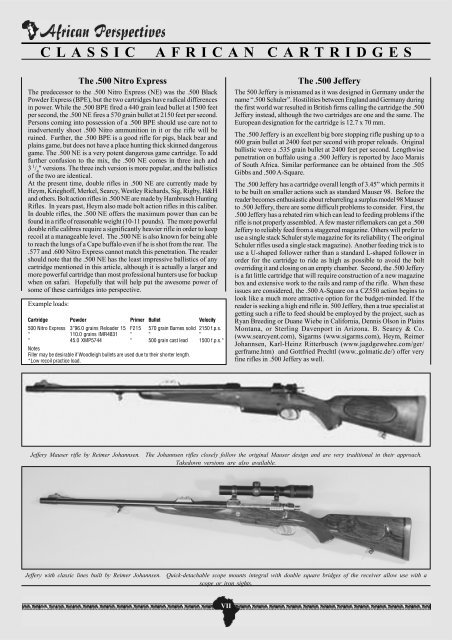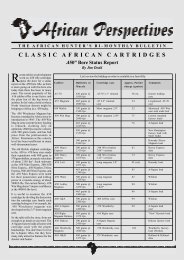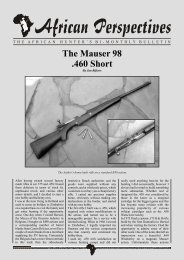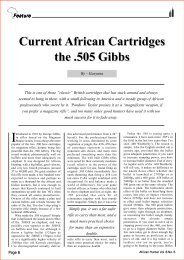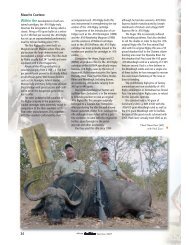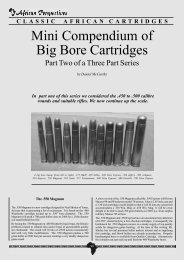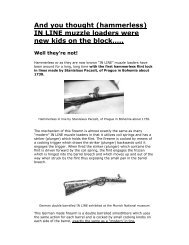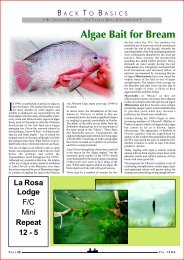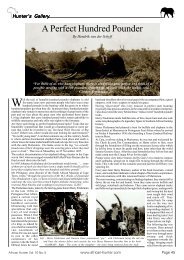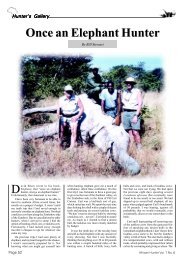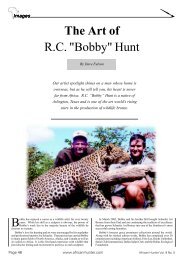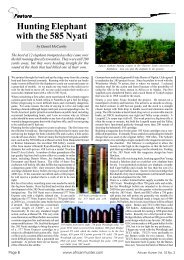Mini Compendium of Big Bore Cartridges - HuntNetwork
Mini Compendium of Big Bore Cartridges - HuntNetwork
Mini Compendium of Big Bore Cartridges - HuntNetwork
You also want an ePaper? Increase the reach of your titles
YUMPU automatically turns print PDFs into web optimized ePapers that Google loves.
CLASSIC<br />
AFRICAN CARTRIDGES<br />
The .500 Nitro Express<br />
The predecessor to the .500 Nitro Express (NE) was the .500 Black<br />
Powder Express (BPE), but the two cartridges have radical differences<br />
in power. While the .500 BPE fired a 440 grain lead bullet at 1500 feet<br />
per second, the .500 NE fires a 570 grain bullet at 2150 feet per second.<br />
Persons coming into possession <strong>of</strong> a .500 BPE should use care not to<br />
inadvertently shoot .500 Nitro ammunition in it or the rifle will be<br />
ruined. Further, the .500 BPE is a good rifle for pigs, black bear and<br />
plains game, but does not have a place hunting thick skinned dangerous<br />
game. The .500 NE is a very potent dangerous game cartridge. To add<br />
further confusion to the mix, the .500 NE comes in three inch and<br />
3 1 / 4<br />
" versions. The three inch version is more popular, and the ballistics<br />
<strong>of</strong> the two are identical.<br />
At the present time, double rifles in .500 NE are currently made by<br />
Heym, Kriegh<strong>of</strong>f, Merkel, Searcy, Westley Richards, Sig, Rigby, H&H<br />
and others. Bolt action rifles in .500 NE are made by Hambrusch Hunting<br />
Rifles. In years past, Heym also made bolt action rifles in this caliber.<br />
In double rifles, the .500 NE <strong>of</strong>fers the maximum power than can be<br />
found in a rifle <strong>of</strong> reasonable weight (10-11 pounds). The more powerful<br />
double rifle calibres require a significantly heavier rifle in order to keep<br />
recoil at a manageable level. The .500 NE is also known for being able<br />
to reach the lungs <strong>of</strong> a Cape buffalo even if he is shot from the rear. The<br />
.577 and .600 Nitro Express cannot match this penetration. The reader<br />
should note that the .500 NE has the least impressive ballistics <strong>of</strong> any<br />
cartridge mentioned in this article, although it is actually a larger and<br />
more powerful cartridge than most pr<strong>of</strong>essional hunters use for backup<br />
when on safari. Hopefully that will help put the awesome power <strong>of</strong><br />
some <strong>of</strong> these cartridges into perspective.<br />
Example loads:<br />
Cartridge Powder Primer Bullet Velocity<br />
500 Nitro Express 3”96.0 grains Reloader 15 F215 570 grain Barnes solid 2150 f.p.s.<br />
“ 110.0 grains IMR4831 “ “ “<br />
“ 45.0 XMP5744 “ 500 grain cast lead 1500 f.p.s.*<br />
Notes<br />
Filler may be desirable if Woodleigh bullets are used due to their shorter length.<br />
*Low recoil practice load.<br />
The .500 Jeffery<br />
The 500 Jeffery is misnamed as it was designed in Germany under the<br />
name “.500 Schuler”. Hostilities between England and Germany during<br />
the first world war resulted in British firms calling the cartridge the .500<br />
Jeffery instead, although the two cartridges are one and the same. The<br />
European designation for the cartridge is 12.7 x 70 mm.<br />
The .500 Jeffery is an excellent big bore stopping rifle pushing up to a<br />
600 grain bullet at 2400 feet per second with proper reloads. Original<br />
ballistic were a .535 grain bullet at 2400 feet per second. Lengthwise<br />
penetration on buffalo using a .500 Jeffery is reported by Jaco Marais<br />
<strong>of</strong> South Africa. Similar performance can be obtained from the .505<br />
Gibbs and .500 A-Square.<br />
The .500 Jeffery has a cartridge overall length <strong>of</strong> 3.45” which permits it<br />
to be built on smaller actions such as standard Mauser 98. Before the<br />
reader becomes enthusiastic about rebarreling a surplus model 98 Mauser<br />
to .500 Jeffery, there are some difficult problems to consider. First, the<br />
.500 Jeffery has a rebated rim which can lead to feeding problems if the<br />
rifle is not properly assembled. A few master riflemakers can get a .500<br />
Jeffery to reliably feed from a staggered magazine. Others will prefer to<br />
use a single stack Schuler style magazine for its reliability ( The original<br />
Schuler rifles used a single stack magazine). Another feeding trick is to<br />
use a U-shaped follower rather than a standard L-shaped follower in<br />
order for the cartridge to ride as high as possible to avoid the bolt<br />
overriding it and closing on an empty chamber. Second, the .500 Jeffery<br />
is a fat little cartridge that will require construction <strong>of</strong> a new magazine<br />
box and extensive work to the rails and ramp <strong>of</strong> the rifle. When these<br />
issues are considered, the .500 A-Square on a CZ550 action begins to<br />
look like a much more attractive option for the budget-minded. If the<br />
reader is seeking a high end rifle in. 500 Jeffery, then a true specialist at<br />
getting such a rifle to feed should be employed by the project, such as<br />
Ryan Breeding or Duane Wiebe in California, Dennis Olson in Plains<br />
Montana, or Sterling Davenport in Arizona. B. Searcy & Co.<br />
(www.searcyent.com), Sigarms (www.sigarms.com), Heym, Reimer<br />
Johannsen, Karl-Heinz Ritterbusch (www.jagdgewehre.com/ger/<br />
gerframe.htm) and Gottfried Prechtl (www..golmatic.de/) <strong>of</strong>fer very<br />
fine rifles in .500 Jeffery as well.<br />
Jeffery Mauser rifle by Reimer Johannsen. The Johannsen rifles closely follow the original Mauser design and are very traditional in their approach.<br />
Takedown versions are also available.<br />
Jeffery with classic lines built by Reimer Johannsen. Quick-detachable scope mounts integral with double square bridges <strong>of</strong> the receiver allow use with a<br />
scope or iron sights.<br />
VII


